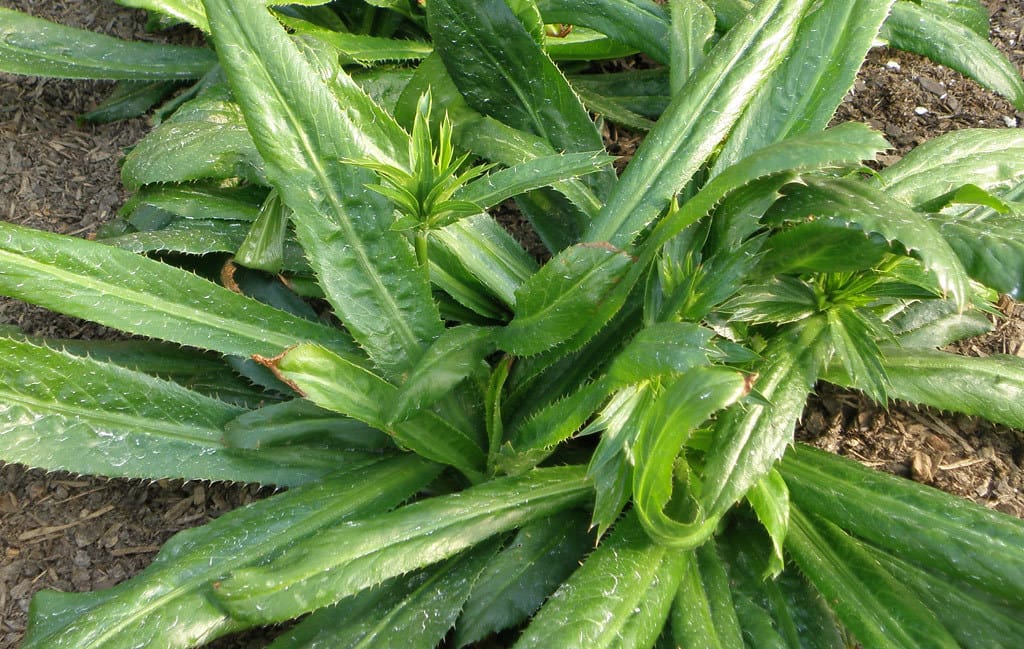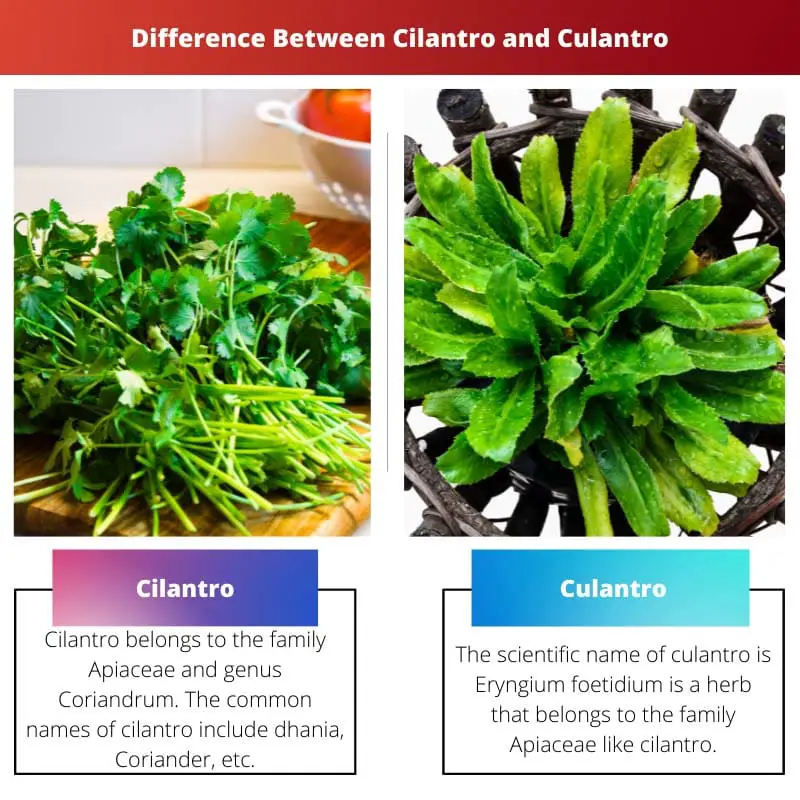When we hear the words cilantro and culantro, we might think it is a typo if we have no idea about these herbs. These herbs are different from each other, with few similarities and dissimilarities.
Both of these herbs are famous in the culinary world. Cilantro leaves are smaller than cilantro. Both of these can be vice versa used. Both herbs are known to have numerous health benefits along with a tangy taste.
Key Takeaways
- Cilantro features delicate, lacy leaves and a mild, citrusy flavor popular in Mexican and Indian cuisines.
- Culantro has long, serrated leaves and a stronger, more pungent taste used in Caribbean and Latin American dishes.
- Cilantro and culantro are not interchangeable, as they have different flavors, appearances, and culinary applications
Cilantro vs Culantro
Cilantro is used raw, but it needs to be added less when culantro is used due to its more robust flavour. Also, cilantro is a herb found in winter, whereas culantro is found throughout the year. Culantro is the chef’s special ingredient because of the different and intense taste and smell, but cilantro has a more homely flavour. Both herbs are used in the world depending upon the need of the dish.

Cilantro is a herb that belongs to the family Apiaceae. It belongs to the Coriandrum genus. Cilantro has a higher shelf life than cilantro. It is a herb that resembles Parsley. Therefore, it is also known as Chinese Parsley.
The flavour of cilantro is lighter and is widely used in decorating cuisines. All parts of the herb are edible and are used to enhance the flavours of the food. The herb belongs to North America, Asia, and Europe.
Culantro is a herb that belongs to the family Apiaceae, but the genus is Eryngium. It tastes harder than cilantro. Culantro leaves are long and thin with serrated edges.
The herb is used in less quantity as compared to cilantro. The herb is mainly used for marinating, garnishing, and seasoning food. It is found in Central America, Europe, and parts of Asia.
Culantro is a herb that belongs to the family Apiaceae, but the genus is Eryngium. It tastes harder than cilantro. Culantro leaves are long and thin with serrated edges.
The herb is used in less quantity as compared to cilantro. The herb is mainly used for marinating, garnishing, and seasoning food. It is found in Central America, Europe, and parts of Asia.
Comparison Table
| Parameters of Comparison | Cilantro | Culantro |
|---|---|---|
| Genus | Coriandrum | Eryngium |
| Taste and flavor | Lighter taste and flavor | Stronger taste and pungent flavor |
| Location | North America, Asia and Europe | Central America, Europe and parts of Asia |
| Leaves | Smaller leaves with feather-like edges | Long and thin leaves with serrated edges |
| Growth | Cilantro needs to be replanted every year. | Culantro is perennial. It can grow from same shoot for several years. |
What is Cilantro?
Cilantro belongs to the family Apiaceae and the genus Coriandrum. The common names of cilantro include dhania, Coriander, etc. Cilantro is a Spanish word used for Coriander.
Leaves and seeds are most popularly used, although all the parts are edible. Cilantro has a lime-like taste due to the presence of aldehydes.
Cilantro is native to Northern America, Southern Europe, and Asia. The plant goes up to a length of 52 cm in height. The leaves of this plant are slender, feather-like in appearance.
The flowers are white and light pink without any symmetry. Cilantro leaves have 91% water, 5% carbohydrates, 2.5% protein, and less than 1.5% fat.
Cilantro leaves are used to enhance the flavour of cuisines. In the culinary world, the leaves are used to decorate the food platters.
The leaves are always used raw and never cooked because heat vanishes the tangy flavour. Leaves and seeds have different tastes. While the leaves are used to make chutney and salads, the seeds are used as masala in every Indian food.

What is Culantro?
The scientific name of culantro is Eryngium foetidium is a herb that belongs to the family Apiaceae like cilantro. The genus of culantro is different from cilantro.
Culantro is known for its high citrus taste. Culantro is native to Central America, Europe and parts of Asia. The herb could be grown through the same shoot almost permanently.
It retains its tangy and strong flavour even after drying, making it an essential herb in the culinary industry, unlike cilantro. It is used as a replacement for cilantro, but it is used in less quantity due to its strong flavour.
Apart from using the herb in foods, it is also used in traditional medicines to cure malaria, diarrhoea, burns, earache, etc. It is known to calm the mind of a person and is also known by common names like fitweed and spiritweed.
Culantro is also known for its anti-inflammatory, anti-microbial, analgesic and anticonvulsant properties due to the presence of a compound called Eryngial.
The compound is found to treat fevers, chills, headaches, vomiting, and hypertension. Tannins, saponins and alkaloids give it special flavour and healing properties.
In the food industry, it is a chef’s favourite herb because of its different flavours. It doesn’t lose its flavour even after heating or drying.
The flavour of cilantro is mesmerizing for some but rotten for others. It depends upon the individual’s taste whether to like it or not.

Main Differences Between Cilantro and Culantro
- The genus of cilantro is Coriandrum, whereas the genus of culantro is Eryngium.
- Cilantro loses its flavour after drying, but culantro retains the flavour after drying.
- Cilantro needs to be replanted every year, whereas culantro, a perennial herb, can grow from the same shoot for many years.
- Cilantro’s leaves give a feather-like appearance, but culantro leaves are long and thin with serrated edges.
- Cilantro has a light flavour, but culantro has a stronger flavour.

- https://www.hort.purdue.edu/newcrop/proceedings1999/pdf/v4-506.pdf
- https://faseb.onlinelibrary.wiley.com/doi/abs/10.1096/fj.201900485R

The distinction between the uses of cilantro and culantro in various world cuisines is intriguing. I appreciate the level of detail provided in this article.
Yes, the cultural and culinary significance of these herbs was very well explained in this article.
I found the information on the nutritional content of cilantro and culantro to be particularly interesting. Thank you for this comprehensive and enlightening article.
I couldn’t agree more. The article provided a thorough exploration of the differences between these two herbs.
This article provides a detailed account of the differences between cilantro and culantro. It’s useful information for anyone interested in culinary herbs.
Thank you for this informative article on the differences between cilantro and culantro. It’s fascinating to learn that they have different flavors and appearances, and that they are used in different culinary applications.
I couldn’t agree more. This article provided some really interesting insights into these two herbs.
The information about cilantro and culantro’s respective nutritional content and their uses in cuisines around the world was a fascinating read. Thank you for sharing this knowledge with us.
I completely agree. I appreciate the depth of information provided in this article.
The details about the flavor and culinary uses of cilantro and culantro were very enlightening. This was an insightful article.
I found it particularly interesting to learn about the different culinary applications of cilantro and culantro around the world.
I couldn’t agree more. The explanations regarding the flavor and uses of these herbs were fascinating.
The culinary applications and uses of cilantro and culantro in various cuisines were well-highlighted in this article. Very informative indeed.
I found the comparison of the uses of cilantro and culantro in different cuisines to be quite helpful and informative.
I agree. The insights into their various uses added a lot of value to this article.
The comparison table provides a clear overview of their differences, particularly about the genus, taste, flavor, and locations of cilantro and culantro. This is a very well-written and informative article.
I found the details about the shelf life and culinary uses of both herbs to be quite enlightening. A very educational read.
The information about the nutritional content and uses of cilantro and culantro was a valuable read. It’s great to learn more about these herbs.
Absolutely. The level of detail and clarity provided in this article is commendable.
The details on the biology and growth patterns of cilantro and culantro were very enlightening. I’ve learned a lot from this article.
I agree. I found it particularly interesting to learn about the differences in growth between cilantro and culantro.
Absolutely. It’s great to have such an in-depth analysis of these two herbs.